Human Flower Project
Six Plants People Want to See
Which plants draw a crowd and why? The EarthScholars study celebrities of the botanical world and consider how their starpower can be harnessed for good.

“It’s Superplant!”—or one of them: Monkey Puzzle Tree
Photo: David Griffin
By James H. Wandersee and Renee M. Clary
EarthScholars™ Research Group
In a recent (2009) article entitled the “10 Most Interesting Plants in the World and Where to Find Them,” Canadian garden designer Ailsa Francis names and describes ten plants she finds especially fascinating, and spots a location or two where people can observe each of her chosen plants.
Since Francis follows the streamlined format of Canada.com, meant to be concise, enticing and actionable, we don’t learn how she arrived at her ten selections—or if, besides personal preference, she used any method at all. However, we do think it’s a good list; she chose four of the same plants that our own archival and on-site research uncovered!
Botanic Gardens Conservation International, with over 500 public garden members worldwide, states that “the best estimate we have of the number of known plant species is around 400,000.” That’s a lot of “top plants” candidates! From such a wide range of alternatives, we wondered how to arrive systematically at a small list of plants that are (a) accessible to the public in multiple gardens, parks, and arboreta and (b) that historically, people most want to see—plants people actually seek out and declare their intention to visit.
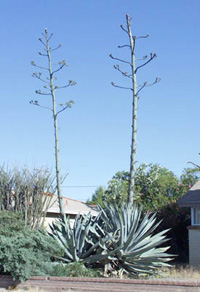 Century plant (Agave Americana) sending up flower stalks in Arizona
Century plant (Agave Americana) sending up flower stalks in Arizona
Photo: University of Arizona
We decided such plants needed a category name. At the 2001 annual meeting of the Botanical Society of America, a report by our research group defined a marquee plant as follows:
(a) A plant species that strongly attracts the public’s attention and invites its direct observation;
(b) a plant species that, during some or all of its life cycle, is capable of drawing a crowd at a botanic garden;
(c) a plant species that may serve as a portal to public understanding of plants.
To determine which species qualified as marquee plants, we set out on three avenues of research. First, we took a sample of 300 plant-related articles from the world’s leading newspapers, and through content analysis examined how writers described both the plants and their ability to engage the public. We then identified and analyzed some key visual characteristics of an emergent set of exemplary “marquee plants” commonly featured at botanic gardens—collecting information on visitation times and on-site visitor comments. Third, we composed a set of attributes derived from marquee plants that emerged in the study. We believe that botanical educators can use these plant attributes to predict other potential marquee plants, species that may be useful in teaching and promoting public understanding of plants.
Analyzing the US and European print articles about plants that drew crowds at botanic gardens, arboreta, and parks, we found six species whose media coverage length and frequency data set them apart from all other plant candidates. Open to making a list of any length, we let the data dictate the number of plants — looking for an authentic divide between the most-curiosity-inducing plants and those with more modest appeal. We found that just six plants received significantly more public attention and media coverage than our other candidates. (Ten has cultural significance in the US and some other countries; Chinese tradition holds special reverence for the number 8, associated as a homonym with “luck.”)
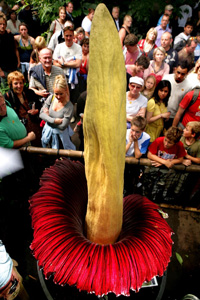 Titan Arum Plant (“Corpse Flower”) in bloom at the Eden Project, UK
Titan Arum Plant (“Corpse Flower”) in bloom at the Eden Project, UK
Photo: Eden Project
The results of our content analysis led us to study the visual characteristics of our emergent six “superstar” plants: Agave americana (Century Plant), Amorphophallus titanum (Titan Arum), Araucaria araucana (Monkey Puzzle Tree), Musa sapientum L. (Grocer’s Banana or Sweet Banana), Lithops sp. (Living Stones), and Victoria amazonica (giant Amazonian water lily).
We studied these plants on location at five famous European botanic gardens in five countries—Belgium, England, Germany, Holland, and Scotland— observing how visitors reacted to them, and measuring how long people lingered in their direct experiences with each plant. These observations allowed us to triangulate and share our findings about why the public is attracted to each of the six plants we studied.
Although the scientists and the plant science literature associated with each of these delightful marquee plants merit separate HFP articles, here we simply want you to think about what plant characteristics most attract your attention and arouse your curiosity.
Here are the sensory variables (predominantly visual) that we found in our study, in descending order of their documented attraction to humans and arousal of curiosity:
1. Variables: Inflorescence SIZE and putrid SCENT
Titan Arum (above)

UK Prime Minister Margaret Thatcher at Kew Gardens (London) marveling at the Giant Amazonian Water Lilies
Photo: Prance Family
2. Variables: Leaf SIZE and leaf SHAPE
Giant Amazonian Water Lily (above)
3. Variables: Leaf HARDNESS, leaf SHARPNESS, and leaf ANGULARITY
Monkey Puzzle Tree (1st and 7th photos)
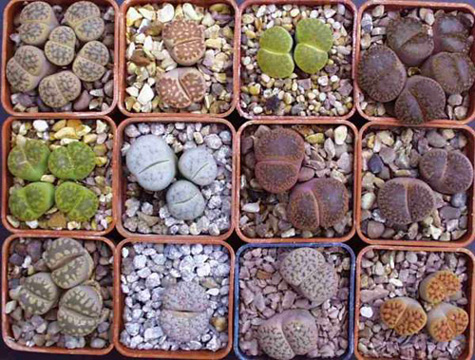
Living Stone Species Growing at UC Botanical Garden at Berkeley
Photo: Rudy Rucker
4. Variables: CAMOUFLAGE and MIMICRY
Living Stones (above)
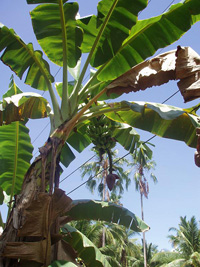 Bananas Growing in Dalahikanon, on Cebu Island, Philippines
Bananas Growing in Dalahikanon, on Cebu Island, Philippines
Photo: Dalahikan
5. Variables: FRUIT POPULARITY and PLANT UNFAMILIARITY
Grocer’s Banana Plant
6. Variables: Purported LONGEVITY, HEIGHT of inflorescence, sudden, explosive GROWTH RATE (in plant height) foreshadowing its own death
Century Plant (2nd image above)
All six of these plants are indeed “people magnets.” Julie Ardery, HFP’s founding editor, has provided an perfect example of this in her HFP essay on the public’s response to corpse flower (Titan Arum) bloomings both here and abroad in her article entitled “Rock Star.” Such bloomings have attracted as many as 55,000 people, and have even driven high volume Titan Arum t-shirt sales—with shirts imprinted especially to commemorate the visitor’s presence at this rare and impressive flowering event!
The four plants that appeared on both Ailsa Francis’ list of 10 and our own are Titan Arum, Monkey Puzzle Tree, Giant Amazonian Water Lily, and the Century Plant. The 66% agreement bolsters our confidence in our study’s findings.
Although we identified just six plants as model marquee plants, we realized their popularity may have been partially due to the fact that botanical institutions may have highlighted these plants in their press releases, marketing channels, plant tours, or on-site signage. Parks seemed to receive less media coverage, especially of their native plants. We acknowledge that studies employing other research methods might yield divergent findings as to plants and plant characteristics that attract botanical garden, arboretum, and park visitors, and arouse their curiosity.
After we completed our study, we discovered a copy of the Guinness Book of World Records containing records for the following eclectic attribute categories of wild plants: (a) tallest tree; (b) most massive tree; (c) fastest growing tree; (d) tree with the deepest roots; (e) oldest tree; (f) biggest weed; (g) most damaging weed; (h) biggest and smalliest flowers; (i) biggest orchid flower; (j) biggest leaves; (k) largest roots; (l) fastest growing plant; (m) biggest and smallest seeds; and (n) tallest cactus. What we learned from their record-categories is that those traits represent plant attributes that attracted readers of this popular, annually undated, self-reported/staff-verified record book. Later editions have added categories like plant with most leaves, heaviest apple, largest tree transplanted, and tallest rose bush.
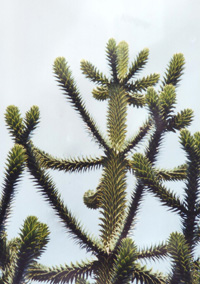 The top of a Monkey Puzzle Tree, Royal Botanic Garden—Edinburgh, Scotland
The top of a Monkey Puzzle Tree, Royal Botanic Garden—Edinburgh, Scotland
Photo: EarthScholars Research Group
Thus, from the Guinness book, we find that readers expressed their interest in the following plant traits:
1. height
2. depth
3. longevity
4. biomass
5. size
6. scent
7. growth rate
8. number
Our study uncovered the importance of all of those variables except (root) depth and number.
We did, however, document the importance of these additional plant characteritics:
9. shape
10. hardness
11. sharpness
12. angularity
13. camouflage
14. mimicry
15. fruit popularity (coupled with plant unfamiliarity)
Congruently, Ailsa Francis’ article also values plant longevity, size, biomass, and shape. She adds one more variable that makes eminent sense to us:
16. color
Interestingly, at these very five botanic gardens, we also discovered several under-publicized and under-interpreted species that harbored the potential to become “marquee plants.” If these plants could be reconceptualized, reinterpreted, and marketed as noteworthy, we predict that visitors would soon flock to see the “star quality” in each of them, as well. We also think our listing of 16 perceptual variables [above] may be helpful to those professionals interested in expanding the number of marquee plants at their botanical garden, arboretum, or park.
An example of a potential marquee plant that we’ve seen already growing in many botanic gardens is Gunnera manicata (commonly called Giant Rhubarb Plant), native to the mountains of Columbia and Brazil. Although it appears, from a distance, to be “Garden Rhubarb on steroids,” they two species are not closely related.
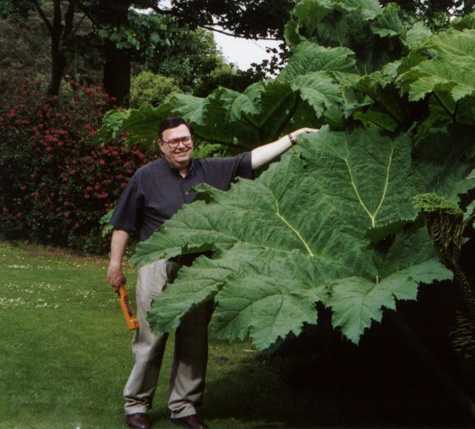
Single leaf of a young Gunnera manicata bog specimen, Logan Botanic Garden in Scotland
Photo: EarthScholars Research Group
We consider Gunnera manicata to be the terrestrial marquee plant-analog of the Giant Amazonian Water Lily. Once this land-loving Amazon is well-publicized and well-interpreted, we think the public will be fascinated by its many maximums: 10-foot height, 144-square foot spread, and gigantic green leaves that can grow to be up to 8 feet wide—what great solar collectors! The leaves’ undersides have a different color (red) and are covered with spikes, as are the 5-foot-long leaf stalks (petioles). The upper surface of each leaf is heavily textured, and the leaf’s contoured shape serves to catch and channel water to the plant’s roots.
There are “people stories” behind this plant as well. Classified by Linnaeus, he named its genus Gunnera to honor his close friend (whom he knew only via correspondence), the noted Norwegian botanist Johann Ernst Gunnerus, who was the first to study systematically the plants of Norway. Johann wrote the Flora of Norway (1766-1776). He enjoyed studying many facets of natural history—including marine organisms and the aurora borealis phenomenon. The Trondheim Society which he co-founded in 1760 (as the Bishop of Trondheim) became the Royal Norwegian Society of Sciences and Letters in 1767. Today’s Norwegian University of Science and Technology (NTNU) in Trondheim has a new research vessel, the R/V Gunnerus, named in his honor.
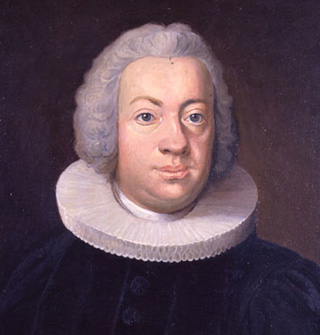 Portrait of Johann Ernst Gunnerus (1718-1773), Norwegian Botanist and Bishop
Portrait of Johann Ernst Gunnerus (1718-1773), Norwegian Botanist and Bishop
Photo: via wiki
At the macro-/microscopic level, when growing in nitrogen deficient soil, Gunnera manicata plants develop stem glands. The plants then form a symbiotic relationship with a nitrogen-fixing Cyanobacteria (Nostoc punctiforme). The bacteria enter the plant through these stem glands found at the bases of leaf stalks and then trigger an intracellular symbiosis, giving the plant fixed nitrogen in return for taking some of its fixed carbon for the bacteria’s metabolism. This “in-between-plant-cells interaction” is unique in higher plants, and may help plant scientists initiate novel symbioses between crop plants and cyanobacteria—allowing specific plants to grow in areas lacking fixed nitrogen in the soil. At present, Gunnera is the only genus of angiosperms (flowering plants) known to host Cyanobacteria (formerly called Blue-Green Algae). This is but another fascinating story to be told about Gunnera manicata.
All potential marquee plants have important tales to tell, attributes for visitors to experience, and useful plant science for people to learn. It’s up to those of us who care about increasing the public understanding of plants to expand and interpret the set of marquee plants. We can help botanical visitors to engage as many of their senses as possible, tell them memorable plant-related stories, and guide their observations through this wondrous group of green teachers.


Brilliant research protocol. I am using content analysis in my own work. (Would like to see your bibliography, if possible).
Are marquee plants similar to “charismatic fauna”?